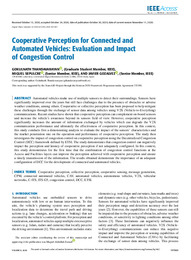Por favor, use este identificador para citar o enlazar este ítem:
https://hdl.handle.net/11000/30965
Cooperative Perception for Connected and Automated Vehicles: Evaluation and Impact of Congestion Control
Título :
Cooperative Perception for Connected and Automated Vehicles: Evaluation and Impact of Congestion Control |
Autor :
Thandavarayan, Gokulnath 
Sepulcre, Miguel 
Gozalvez, Javier |
Editor :
Institute of Electrical and Electronics Engineers |
Departamento:
Departamentos de la UMH::Ingeniería de Comunicaciones |
Fecha de publicación:
2020-10-30 |
URI :
https://hdl.handle.net/11000/30965 |
Resumen :
Automated vehicles make use of multiple sensors to detect their surroundings. Sensors have significantly improved over the years but still face challenges due to the presence of obstacles or adverse weather conditions, among others. Cooperative or collective perception has been proposed to help mitigate these challenges through the exchange of sensor data among vehicles using V2X (Vehicle-to-Everything) communications. Recent studies have shown that cooperative perception can complement on-board sensors and increase the vehicle's awareness beyond its sensors field of view. However, cooperative perception significantly increases the amount of information exchanged by vehicles which can degrade the V2X communication performance and ultimately the effectiveness of cooperative perception. In this context, this study conducts first a dimensioning analysis to evaluate the impact of the sensors' characteristics and the market penetration rate on the operation and performance of cooperative perception. The study then investigates the impact of congestion control on cooperative perception using the Decentralized Congestion Control (DCC) framework defined by ETSI. The study demonstrates that congestion control can negatively impact the perception and latency of cooperative perception if not adequately configured. In this context, this study demonstrates for the first time that the combination of congestion control functions at the Access and Facilities layers can improve the perception achieved with cooperative perception and ensure a timely transmission of the information. The results obtained demonstrate the importance of an adequate configuration of DCC for the development of connected and automated vehicles.
|
Palabras clave/Materias:
Cooperative perception
collective perception
cooperative sensing
message generation
CPM |
Área de conocimiento :
CDU: Ciencias aplicadas: Ingeniería. Tecnología |
Tipo de documento :
info:eu-repo/semantics/article |
Derechos de acceso:
info:eu-repo/semantics/openAccess
Attribution-NonCommercial-NoDerivatives 4.0 Internacional |
DOI :
http://dx.doi.org/10.1109/ACCESS.2020.3035119 |
Publicado en:
IEEE Access ( Volume: 8) 2020 |
Aparece en las colecciones:
Artículos Ingeniería Comunicaciones
|
 La licencia se describe como: Atribución-NonComercial-NoDerivada 4.0 Internacional.
La licencia se describe como: Atribución-NonComercial-NoDerivada 4.0 Internacional.

 La licencia se describe como: Atribución-NonComercial-NoDerivada 4.0 Internacional.
La licencia se describe como: Atribución-NonComercial-NoDerivada 4.0 Internacional.
.png)